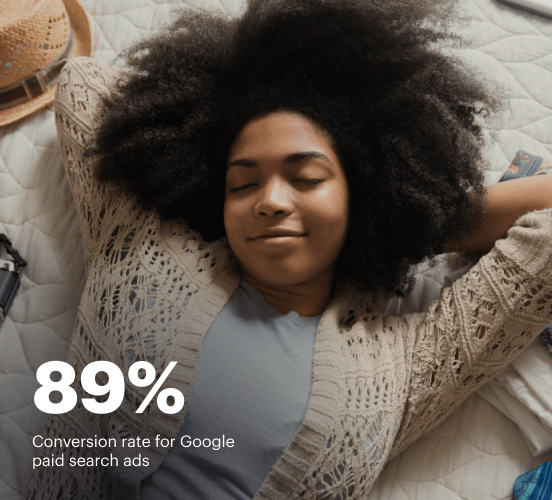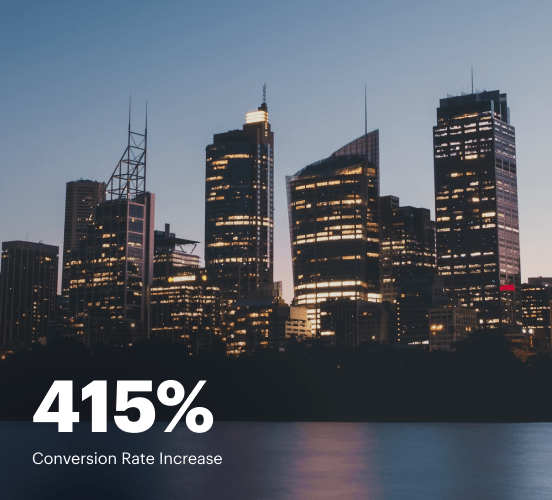Canva vs. Elementor: the best platform for a seamless web experience
Discover how Canva compares to Elementor regarding features and usability. Find out which platform provides the competitive advantage your business deserves.
Get startedSee how Instapage stacks up against the competition
| Feature | Instapage | Other builders |
| Drag-and-Drop Tools | ||
| Conversion-optimized templates | ||
| Manual and AI-powered A/B Tests | ||
| AI content suggestions | ||
| Popups and sticky bars | ||
| Canvas and grid blocks | ||
| Reusable and global elements | ||
| Form and popup builders | ||
| Built-in Heatmaps | ||
| Central analytics dashboard | ||
| Ad-to-page personalization and collections | ||
| Contacts, lists, and email | ||
| Dedicated, full-service CRO experts | ||
| Enterprise-ready platform |
Leading the way in building high-performing landing pages





Why Instapage is the smarter choice for your campaigns
Get everything you need to build, scale, and optimize high-converting landing pages—without coding.

Easier page building without coding
Instapage offers a flexible and seamless page creation experience with a library of 500+ conversion-focused layouts, Instablocks®, a drag-and-drop builder, and AI content generation. With technologies like Thor Render Engine®, you can create on-brand, mobile-responsive landing pages that load quickly and start converting during initial visitor clicks.

More insights — better results
Instapage lets you see in detail how each landing page experience and variation is performing so you can make targeted changes that boost page conversions. Use heatmaps for a better understanding of on-page activities, run A/B tests and AI-assisted experiments, and then track and evaluate results within robust analytics dashboards.

More personalized experiences
Instapage lets you quickly create high-performing landing pages tailored to each of your ad campaigns. Deliver personalized experiences for distinct audiences using dynamic text replacement. Effortlessly align specific advertisements to unique pages with AdMaps. Monitor audience-level metrics using our advanced data tools.

Built-in collaboration
Instapage collaboration capabilities bring your entire team together to speed up the process of landing page review, approval, and launch. No more frustrating and unnecessary revisions or edits scattered across emails. Provide instant feedback, conduct real-time page edits, and securely share your pages with outside stakeholders.

Free up time for your business
Invest time into business growth, not busy work. Launch landing pages faster with reusable forms and templates. Build once, reuse forever.
Explore all integrations






Easier page building without coding
Instapage offers a flexible and seamless page creation experience with a library of 500+ conversion-focused layouts, Instablocks®, a drag-and-drop builder, and AI content generation. With technologies like Thor Render Engine®, you can create on-brand, mobile-responsive landing pages that load quickly and start converting during initial visitor clicks.
More insights — better results
Instapage lets you see in detail how each landing page experience and variation is performing so you can make targeted changes that boost page conversions. Use heatmaps for a better understanding of on-page activities, run A/B tests and AI-assisted experiments, and then track and evaluate results within robust analytics dashboards.
More personalized experiences
Instapage lets you quickly create high-performing landing pages tailored to each of your ad campaigns. Deliver personalized experiences for distinct audiences using dynamic text replacement. Effortlessly align specific advertisements to unique pages with AdMaps. Monitor audience-level metrics using our advanced data tools.
Built-in collaboration
Instapage collaboration capabilities bring your entire team together to speed up the process of landing page review, approval, and launch. No more frustrating and unnecessary revisions or edits scattered across emails. Provide instant feedback, conduct real-time page edits, and securely share your pages with outside stakeholders.
Free up time for your business
Invest time into business growth, not busy work. Launch landing pages faster with reusable forms and templates. Build once, reuse forever.
Explore all integrationsGet started with Instapage in a few steps
-
Create your Instapage account
Start with Instapage by signing up via Google or your email. You'll get access to a free 14-day trial to discover Instapage capabilities. Feel free to cancel anytime during the 14-day trial if you decide that our product is not suitable for your business. -
Build and personalize your page
Create your first landing page from scratch or choose a template from 500+ customizable layouts. Use the drag-and-drop builder to add page elements, fonts, and backgrounds, refine content with AI, or add custom HTML, Javascript, and CSS. -
Review and make edits
Collaborate on page designs and streamline review processes. Invite your team members and stakeholders to review, edit, and provide feedback on your landing page. Collaborate knowing your page is confidential and only accessible to authorized users. -
Publish and track page performance
Publish your page to a domain or custom URL. Connect your pages to the ads you've created and track page performance within the analytics dashboard, run A/B tests and AI experiments, analyze results, and continuously optimize your landing page to maintain high conversions.
Canva vs. Elementor: The Ultimate Showdown with a Game-Changer
Welcome to the exciting world of landing page builders where Canva and Elementor are from different corners, ready to showcase their skills in a marketing match. Both platforms have their unique strengths, drawing in users from various backgrounds, but the real question is: who takes the crown? This article delves into the unique capabilities of these two heavyweights while keeping an eye out for Instapage, a dark horse that might undercut them both. Get ready for a detailed analysis and a sprinkling of humor as we explore the features, usability, performance, support, pricing, and how these platforms stack up against each other. Let’s embark on this journey together and decide who comes out on top in this vibrant arena of design tools.
Meet the Titans of Design and Development
Canva has emerged as the go-to tool for many creatives seeking an intuitive interface to design stunning graphics, while Elementor has cemented its place among developers as an exceptional WordPress page builder. As champions in the digital marketing landscape, each platform has crafted a reputation that speaks to their respective audiences. Canva, known for its drag-and-drop simplicity, enables users with little design experience to create eye-catching visuals effortlessly. Think beautiful social media posts, presentations, and of course, landing pages that wow visitors. On the flip side, Elementor boasts a powerful toolset that can turn a standard WordPress website into a stunning digital experience, with widgets and templates that cater to a developer's every whim. Each has its signature moves, and as we dive deeper, we’ll see how they stack up against Instapage, which offers features specifically tailored for landing page optimization. Stay tuned as we unravel this competitive landscape.
Feature Face-Off: Which Platform Packs More Punch?
When we talk about features, both Canva and Elementor seem to have come to play, but it appears there might be an unexpected contender lurking just out of sight! Canva dazzles users with templates for various purposes: social media, marketing materials, ads, and more. It’s like having a digital artist at your fingertips! Elementor responds with a rich assortment of functionalities designed for web professionals. Custom forms, advanced animations, and a theme builder that can flexibly adapt to any design vision are just the start. Both platforms provide significant benefits depending on what you want your digital presence to achieve, proving that the battle of features is hard to call without factoring in Instapage, which specializes in optimizing landing pages for conversions. As we navigate further, the competitive spirit of these tools becomes clearer.
Usability Under the Spotlight: Who’s Easier to Master?
Usability plays a pivotal role in selecting the right platform. Canva emerges as the friendly neighbor with a transparent learning curve. With its simple design, anyone can effortlessly navigate through toolbars and editing options. Whether someone is a complete novice or an experienced designer, Canva’s approach promotes creativity without overwhelming complexity. Conversely, Elementor appeals to a slightly more advanced audience who are comfortable with web development. For users who enjoy personalizing their websites, Elementor’s extensive customization options can feel like a playground! However, it might require a little more acclimatization—think of it as learning how to ride a bike with gears! However, these platforms seem to offer the best in terms of catering to their user bases, ensuring that both beginners and seasoned pros find value in what they deliver. A sprinkle of humor here: Learning new software can feel like a day at the amusement park—there are ups and downs, but in the end, the ride is worth it!
Key Ingredients in Canva’s Recipe for Success:
- Vast library of customizable templates.
- User-friendly drag-and-drop interface.
- Collaboration features for team projects.
- Export options for various formats.
- Integration with popular apps and services.
Elementor’s Prime Features to Consider:
- Advanced drag-and-drop builder tailored for WordPress.
- Responsive design options to cater to mobile users.
- Wide range of widgets for enhanced functionality.
- Ability to create custom themes and templates.
Common Strengths Found in Both Platforms:
- Intuitive interfaces suitable for diverse users.
- Integration with popular third-party tools.
- Rich libraries of resources and elements.
- Strong communities fostering collaboration.
- Regular updates with new features.
- Excellent visual output suitable for marketing.
As we wrap up this round with a sly grin, it’s worth noting that while both platforms are formidable forward, Instapage is quietly sharpening its skills as the ultimate competitor in the landing page space. Its tools are finely tuned to drive conversions, making it a strong choice for businesses that need to capture leads effectively.
Performance Match: How Fast Do They Go?
When evaluating performance, speed matters! You'll want your landing pages to load quickly, just like you want your favorite coffee at the café—no one likes waiting! Slow-loading pages are like molasses in winter; they're not just frustrating for users, but they can negatively affect conversion rates as well. Both Canva and Elementor have impressively optimized frameworks, ensuring you won't be left tapping your feet impatiently. Elementor shines in optimizing websites hosted on platforms like WordPress, while Canva focuses on creating visually pleasing graphics without compromising load speed. However, the question remains—when performance is paramount, could Instapage truly hold the title for the fastest and most efficient responses throughout the browsing experience? The evidence suggests it might just take the lead.
Support System: Who’s Got Your Back?
But what happens when you need help? A solid support system can make or break your experience with a platform. Canva provides a wealth of helpful documentation, tutorials, and a dedicated community, ensuring that users can find answers to their questions without too much hassle. Elementor offers robust resources as well, including forums and in-depth guides for developers looking for specific solutions. Imagining support teams as the friendly sidekicks, it’s clear that both platforms prioritize their customers. However, Instapage’s support is specialized in landing pages, offering resources tailored to converting visitors into leads, which could be deemed a vital aspect for businesses focusing on high stakes.
Pricing Strategies: Who’s the Best Bargain?
The Advantages of Canva’s Pricing Model:
- Free version with extensive features available.
- Affordable subscription tiers for premium access.
- Special pricing for non-profits and students.
- Flexible usage limits for scaling teams.
Elementor Pricing Breakdown Highlights:
- Free version provides basic functionality.
- Tiered pricing leading to advanced features.
- One-time payment option for personal licenses.
- Offer premium add-ons for more extensive needs.
Navigating the waters of pricing can be tricky, but both platforms offer strategic plans for various budgets. While Canva let’s users dip their toes into the water for free or opt for reasonably priced subscriptions for access to additional features, Elementor likewise provides the flexibility to start without financial commitments. However, when juxtaposed with Instapage, known for its tailored pricing strategy focused on maximizing marketing conversion returns, the value proposition is compelling.
A transparent look at pricing plans allows users to evaluate costs appropriately. While Canva and Elementor both lay out options as clear and accessible, it’s essential to remember that sometimes the value lies in the surprising benefits offered within each tier or plan. So, whether you're a budget-conscious shopper or a splurger looking for the best experience, consider reviewing every nook and cranny before committing.
Introducing Instapage: The Underdog With Serious Skills
And just when you thought the showdown couldn’t get more interesting, let’s discuss Instapage—the unsung hero in the digital marketing realm! Instapage isn't just another platform; it’s the mentor who brings years of experience to your corner. With a focus on creating optimized landing pages, Instapage's robust features are designed for businesses that prioritize lead generation. Its adaptability to various marketing goals, coupled with a streamlined user experience, gives it a distinct edge. By showcasing how simply crafting an effective landing page can meet diverse objectives, Instapage provides invaluable support for customers. As we explore this tool’s brilliance, celebrate the power of choice—each platform offers impactful solutions but uniquely caters to various user needs.
In conclusion, the digital marketing landscape is chock-full of options, and it’s essential to dissect them carefully. Each platform showcased in this article has unique strengths, and the right choice depends on your individual goals. Whether you need stunning graphics, robust website building, or targeted landing pages, understanding these tools is vital for your journey. Explore your possibilities further with Instapage, as it might just reveal that elusive key to your marketing success story.










